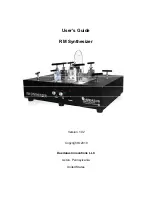
6.3 Envelope
With the envelope modulation source, a set of values are produced based on a user-defined envelope. Unlike
the LFO (which repeats), the envelope only executes once (single shot) when triggered. It’s also a common
feature found in analog synthesis, mostly used for amplitude and filter expression.
Your controls are:
A:
Attack, sets the rate the values rise for the first step of the envelope.
D/R:
Decay / release, determines the rate the values fall for both the decay and release steps of the envelope.
S:
Sustain, sets the level at which the values hold or stay when a key is pressed.
DEST: Modulation destination or target
LVL:
Modulation level for the selected destination. You can have negative values. This allows you to
shape the envelope in the opposite direction.
6.4 Random
The random modulation source, is exactly what the title describes: A random value generator, or as frequently
(but not correctly) described a sample and hold.
Your controls are:
RATE: Speed at which the different values are randomly produced. When the LFO is synced to the unit
BPM, this will also be governed by BPM divisions
LAG:
Time at which different values slide
PROB: Chances that a new value will be produced
DEST: Modulation destination or target
LVL:
Modulation level for the selected destination. You can have negative values. This allows you to
have the random moving into inverted values.
6.5 Step sequencer
Like the note sequencer, the step sequencer is synchronized to the Typhon’s BPM setting, but the two should
not be confused as both provide different functions. While the note sequencer acts like a controller playing
notes, the step sequencer is just another way to modulate parameters like the Filter Cutoff or the waveforms
of the Oscillators.
The step sequencer always runs at the BPM rate, and it will also take advance of the note sequencer param-
eter “DIVISIONS” ( for more info about this go to the “Note sequencer” section). The step sequencer continu-
ously runs in the background, but restarts with every new note trigger, or every time you press the play button
(when play is already engaged, it must first be stopped before it can take action again).
Your controls are:
#:
Number of active steps
Step:
Chosen step to edit
->LVL: Selected step value
DEST: Modulation destination or target
LVL:
Modulation level for the selected destination. You can also have negative values. This lets the
step sequencer modulation subtract from the destination’s values.
Create a step sequencer pattern:
Let’s make a simple pattern that modulates the filter cut off.
1. Push down the encoder and from the menu choose option 1. INITIAL PRESET
10
Summary of Contents for TYPHON
Page 1: ...USER S MANUAL...
Page 4: ...1 3 Block Diagram 4...



































